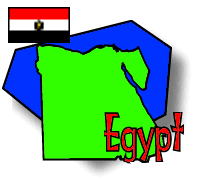
Breakfast: Although andrEa has rebelled against breakfast entirely, preferring to go to the market for something more exciting to start her day (often bananas and yogurt), the rest of us are too lazy! We simply munched on the plain bread with jam and sipped the tea offered at our pension.
Lunch: On our way to Coptic Cairo, some of us grabbed a falafel sandwich just across the street from our hotel. The fun thing is that for these, we can always point at all the other goodies we want stuffed inside with the falafel. While Anthony took the standard route of tahini (a sesame seed paste) sauce, Corinne and andrEa had a flavorful salad and baba ganouj (see the Food of the Day) added to theirs.
Dinner: Working at the inTouch offices late into the night, Corinne and andrEa ordered out for pizza — a favorite urban habit around the world! The boys, however, have developed a very serious addiction to kushari, which they happily ate (again) to calm the craving.
Word of the Day: Lazeez — "delicious"
Person of the Day: Shady Samir
Place of the Day: Living cemetery in Old Cairo ![]()
Tech Fact of the Day: Egyptian Arabic
Group Dispatch, November 23

Questions? Ask Corinne ![]() !
!
 |
 |
 |
 |
 |
|
Itinerary/ Journal |
Discussions |
About Egypt |
eDscape Projects |
Scrapbook |
|
|
|
|
|
|
Internet access while in Egypt was provided by InTouch Communications Services. |
Copyright 1997-2004 BikeAbout. All rights reserved.